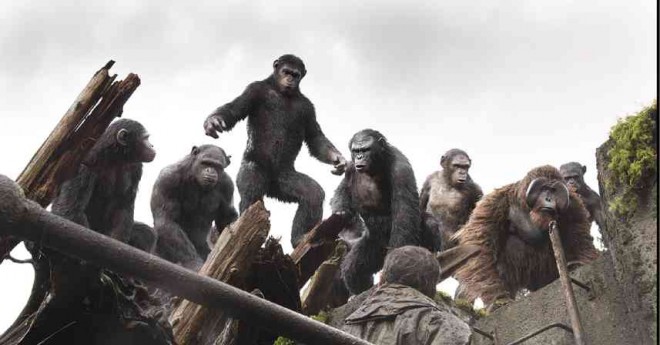
It all started with a virus. In 2011’s “Rise of the Planet of the Apes,” James Franco’s character Dr. Will Rodman had just developed a virus called ALZ-112, which was intended to cure Alzheimer’s Disease.
The drug, tested exclusively on chimpanzees, also had the effect of heightening the chimps’ cognitive abilities, elevating them to a higher form of intelligence. A baby chimp named Caesar was born to a female chimp that had been injected with the drug, becoming the first ape to have had its genes chemically-altered.
A more potent version of the viral-based drug called ALZ-113 was later developed, which was designed to resist the human immune system so that its healing effects couldn’t be reversed by antibodies; however, this very resistance resulted in a backlash so horrifying that only one in 10 humans would survive the new virus, now dubbed the “Simian Flu.”
Caesar would go on to infect other chimps with the virus, leading the amped-up primates on a rampage that would lead them to settle in the Muir Woods in San Francisco to hide from the humans.
Golden age
“Dawn of the Planet of the Apes” takes place 10 years after this incident. For the human race, this decade was fraught with wars, hunger and violent murders in order to survive in true Darwinian form.
But for the genetically-altered chimpanzees living unfettered in the woods, it was a golden age of discovery and evolution. Caesar is now an older and wiser leader, husband and father to an angsty teenage chimp (yes, teenage angst transcends species). After not having seen any humans in a decade, Caesar and his tribe believe that they are the only ones left, and they are content, living off the land in peace.
Meanwhile, on the other side of the woods, in post-Simian Flu San Francisco, a group of humans genetically immune to the virus are hanging on by a thread, the last of their electricity supply on its last spark.
The dam that could restore electricity to the city is located in Muir Woods, where Caesar and his tribe are, which inevitably leads to a confrontation between the two races.
“Dawn of the Planet of the Apes” is a sequel to the ambitious “Planet of the Apes” reboot that started with “Rise of the Planet of the Apes.” Though it takes up where “Rise…” left off, “Dawn…” is a strong stand-alone film, whether or not you are a fan of the original 1968 “Planet of the Apes.”
The producers and writers behind the “Apes” reboot have deconstructed the original plot—high-functioning, human-like apes enslaving humans—and made it their own, resulting in a darker, rawer, more primal struggle for supremacy between apes and humans.
Scene-stealers
Unlike the original 1968 film where the apes spoke in full sentences, the evolution of Caesar and his gang happen more slowly and more realistically. Having been cut off from all human contact since the first film, the primates are in their element in the jungle, operating on instinct tempered with a rapidly developing intelligence, evident in the way they communicate with each other.
The film’s reimagining of a ravaged, dystopian San Francisco is hauntingly beautiful, and while actors Jason Clarke, Keri Russell and Gary Oldman play the part of desperate and defeated humans to perfection, it is Caesar, Koba and the other primates who are scene-stealers.
Andy Serkis (Gollum in “Lord of the Rings,” and Kong in “King Kong”) reprises his role as Caesar. It is amazing just how far performance capture and CGI have evolved in three years (just like the apes in the movie). In previous films that required such technology, all motion-capture sequences had to be performed at a studio, with the background filled in after. This time around, all the motion-capture scenes were done on location, surrounded by accompanying real-time scenarios with fires and explosions.
Serkis, who has become the go-to guy for motion-capture performances, doesn’t only give Caesar human physicality, but also lends him a range of emotions that will have you largely sympathizing with the primates traumatized by experimentation and incarceration by their former human keepers.
It isn’t just the effects and production design that make “Dawn of the Planet of the Apes” a must-see film, but the story itself is engaging and emotional. Yes, it is a fine tale of science fiction, but at its core is also a story of family, loyalty, betrayal and prejudice.
“Dawn of the Planet of the Apes” is already showing in cinemas nationwide. Catch it in 2D, 3D or 4D. The film is distributed by 20th Century Fox.